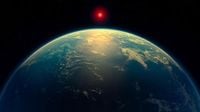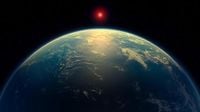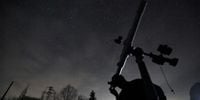A groundbreaking discovery has emerged in the search for extraterrestrial life, as astronomers have identified potential signs of life in the atmosphere of the exoplanet K2-18b, located 124 light-years away from Earth. The findings, published on April 17, 2025, in the journal The Astrophysical Journal Letters, highlight the detection of two chemical compounds, dimethyl sulfide and dimethyldisulfide, using the advanced capabilities of the James Webb Space Telescope.
These sulfur-containing compounds are considered biosignatures, as they are typically produced on Earth exclusively by living organisms, particularly microscopic marine algae known as phytoplankton. This discovery marks a significant milestone for scientists, who assert that they have never been closer to finding evidence of life beyond our solar system.
Nikku Madhusudhan, an astronomer at the University of Cambridge and the lead author of the study, expressed excitement about the implications of their findings. He stated, "What we find at this point are hints of possible biological activities outside our solar system. We have never been this close to a finding that we could assign to life." This statement reflects the researchers' cautious optimism as they navigate the complexities of interpreting data from such a distant planet.
Despite the promising nature of the discovery, the research team has emphasized the need for further observations to validate their results. The spectroscopic signal of the two sulfur compounds is currently considered statistically insignificant, with a significance level of only 3.4 Sigma. Astrophysicist David Clements from Imperial College London noted that a threshold of more than five Sigma would be necessary to make a well-founded claim about the existence of life on K2-18b.
The exoplanet K2-18b was first identified in 2015 by the Kepler space telescope. It orbits a red dwarf star, K2-18, within the habitable zone, where conditions may allow for the presence of liquid water—a crucial element for life as we know it. K2-18b is more than eight times the size of Earth and is believed to consist of silicates and ice, resembling a sub-Neptune rather than a super-Earth.
In the light spectrum of K2-18b's atmosphere, researchers have also detected significant amounts of water vapor, suggesting that the planet may be a hycean planet, enveloped by a deep and hot ocean beneath a dense hydrogen-rich atmosphere. This raises intriguing questions about the potential for life forms that would have evolved under entirely different conditions from those on Earth.
While the detection of dimethyl sulfide and dimethyldisulfide is exciting, scientists caution against jumping to conclusions. Madhusudhan pointed out that the presence of these compounds does not definitively indicate life, as alternative non-biological processes could also produce them. He remarked, "We need to ensure that we are not prematurely claiming to have discovered life. We require more data to substantiate our findings and eliminate other possibilities for the production of these molecules."
The researchers are committed to continuing their observations of K2-18b, with hopes of gathering more data to better understand the origins of the detected compounds. Their work represents a significant step forward in the field of astrobiology, as they strive to uncover the mysteries of distant worlds.
As scientists delve deeper into the complexities of planetary atmospheres, they recognize the challenges posed by limited information from such far-off celestial bodies. Clements acknowledged that interpreting the atmospheric data from K2-18b will always come with reservations and uncertainties. He stated, "Planetary atmospheres are complex and difficult to interpret, especially with the limited information we receive from a planet 124 light-years away. More and better data will help—the first step is to achieve a detection with more than five Sigma to ensure that something interesting exists there."
The significance of this research extends beyond the immediate findings. It represents a pivotal moment in the ongoing quest to discover life beyond our planet, showcasing the advancements in technology that make such explorations possible. Madhusudhan declared, "This is a turning point in the search for life outside our solar system, as we have demonstrated that it is possible to detect biosignatures on potentially habitable planets with today's tools. We have entered the era of observational astrobiology."
In summary, the detection of dimethyl sulfide and dimethyldisulfide in the atmosphere of K2-18b is a monumental step in the search for extraterrestrial life. While the findings are not yet conclusive, they provide a tantalizing glimpse into the potential for biological activity beyond our solar system. As researchers continue to analyze the data and conduct further observations, the scientific community remains hopeful that they may soon unlock the secrets of life on distant planets.






